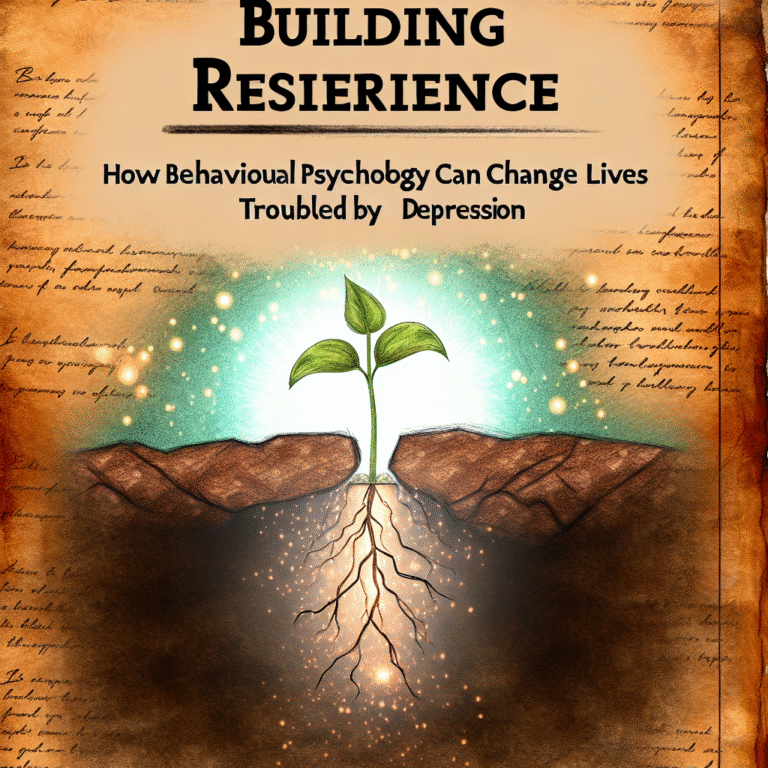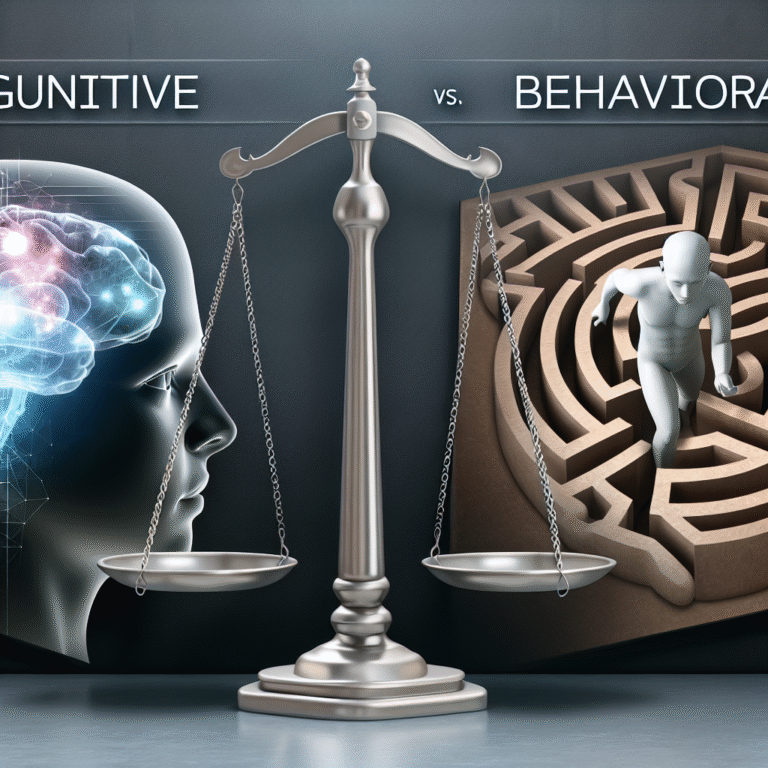
From Theory to Practice: Behavioral Psychology Case Studies That Changed Lives
Introduction
Every day, countless individuals grapple with their thoughts, emotions, and behaviors, often feeling overwhelmed and out of control. The fascinating field of behavioral psychology offers insights and strategies that transform lives, transitioning from abstract theories to hand-on practices that lead to meaningful change. In this article, we’ll delve into the compelling realm of behavioral psychology, showcasing case studies that exemplify the principle: "From Theory to Practice: Behavioral Psychology Case Studies That Changed Lives."
Imagine a young woman named Sarah, who, despite having a stable job and a supportive family, found herself sinking deeper into anxiety and depression. With the help of behavioral techniques grounded in psychological theories, she gradually transformed her life, reclaiming her happiness and confidence. Such stories illuminate the real-world value of behavioral psychology, providing hope and guidance for those looking to overcome their challenges.
In this comprehensive guide, we will explore various case studies that highlight how behavioral psychology works in practice, demonstrating its proven methods and concepts. By presenting these narratives, we will bridge the gap between theory and application, inspiring readers with actionable insights to apply in their own lives.
The Foundations of Behavioral Psychology
Before diving into the case studies, it’s essential to grasp the fundamental concepts of behavioral psychology. This field focuses on the idea that all behaviors are learned through interaction with the environment. Some key theories include:
Classical Conditioning: Proposed by Ivan Pavlov, this theory explains how a neutral stimulus can evoke a response when associated with a stimulus that naturally produces that response.
Operant Conditioning: Developed by B.F. Skinner, this concept suggests that behaviors can be shaped through reinforcement or punishment, influencing the likelihood of a behavior being repeated.
- Cognitive Behavioral Theory (CBT): This approach combines cognitive and behavioral theories, emphasizing the significance of changing negative thought patterns to alter behaviors and emotions.
These theoretical frameworks set the stage for the real-world implications we’ll cover in our case studies.
Case Studies That Changed Lives
Case Study 1: Overcoming Phobias Through Exposure Therapy
Profile: James, a 30-year-old man with a severe fear of flying, managing to maintain his work commitments but feeling the strain.
Theory in Practice: Employing exposure therapy, a technique derived from classical conditioning, James gradually confronted his fear in a systematic way. His therapist designed a step-by-step plan that began with simply imagining being on a plane, gradually progressing to visiting an airport and finally taking a flight.
Analysis: This case illustrates how behavioral psychology techniques—specifically, exposure therapy—can dismantle longstanding fears. By reinforcing the notion that fears can be overcome through gradual exposure, James’s case embodies the practice of "From Theory to Practice: Behavioral Psychology Case Studies That Changed Lives."
| Step | Activity | Emotional Response |
|---|---|---|
| 1 | Imagining flying | Anxiety (high) |
| 2 | Visiting an airport | Anxiety (medium) |
| 3 | Taking a short flight | Anxiety (low) |
Case Study 2: Transforming Negative Thinking with CBT
Profile: Maria, a 27-year-old teacher struggling with chronic negative thoughts that affected her performance and self-esteem.
Theory in Practice: Maria engaged in Cognitive Behavioral Therapy (CBT) to identify and challenge her negative thought patterns. Through structured sessions, she learned to reframe her thinking and replace it with positive affirmations and realistic assessments of her performance.
Analysis: This case exemplifies how cognitive behavioral techniques can be practical tools for transforming internal dialogues. Maria’s journey underscores the concept of "From Theory to Practice: Behavioral Psychology Case Studies That Changed Lives," showing that changing thoughts can fundamentally alter one’s emotional and behavioral landscape.
Case Study 3: Using Reinforcement to Build Better Habits
Profile: Tom, a 45-year-old man aiming to lose weight but struggling to resist unhealthy eating habits.
Theory in Practice: Tom’s approach involved using operant conditioning principles, implementing a reward system where he treated himself to small rewards—like a movie night—every time he met his weekly exercise and dietary goals.
Analysis: Tom’s success highlights the power of positive reinforcement in behavior modification. This case validates the idea embedded in "From Theory to Practice: Behavioral Psychology Case Studies That Changed Lives" by illustrating how rewarding positive behavior can effectively instigate change.
Case Study 4: Addressing Substance Abuse Through Behavioral Interventions
Profile: Lisa, a 32-year-old woman with a substance abuse problem, wanting to cultivate healthier coping mechanisms.
Theory in Practice: Through a structured program based on functional analysis—a key concept in behavioral psychology—Lisa worked to identify triggers for her substance use and developed alternative coping strategies such as mindfulness and exercise.
Analysis: Lisa’s experience is a testament to the effectiveness of behavioral interventions in addressing complex issues like addiction. Her recovery journey encapsulates the essence of "From Theory to Practice: Behavioral Psychology Case Studies That Changed Lives," paving a pathway for others facing similar challenges.
Case Study 5: Building Resilience in Children with Behavioral Challenges
Profile: Jake, a 10-year-old boy exhibiting behavioral challenges in school, often leading to conflicts with his peers and teachers.
Theory in Practice: Behavioral strategies were employed through a school program focused on positive reinforcement. Jake was rewarded for demonstrating appropriate behavior, leading to gradual changes in his interactions with classmates.
Analysis: Jake’s success illustrates how early interventions can have lasting impacts on children’s lives. This case embodies the transition from theoretical principles of reinforcement to practical application, reinforcing the themes in "From Theory to Practice: Behavioral Psychology Case Studies That Changed Lives."
Conclusion
The journey from theory to practice in behavioral psychology reveals the transformative power that these principles can wield in individuals’ lives. Through compelling case studies, we’ve witnessed how concepts such as classical conditioning, operant conditioning, and cognitive restructuring manifest into real-world applications, altering lives dramatically.
As you reflect on the stories presented, consider your experiences and challenges. Just as Sarah, James, Maria, Tom, Lisa, and Jake discovered paths toward betterment, so too can you embark on your journey of change by applying the insights from behavioral psychology.
Actionable Takeaway
Embrace the principles discussed in this article: challenge your negative thoughts, confront your fears, reinforce positive behavior, or seek help for substance abuse. Remember, transformative change is possible, blending theory with practice—"From Theory to Practice: Behavioral Psychology Case Studies That Changed Lives."
FAQs
1. What is behavioral psychology?
Behavioral psychology focuses on understanding and modifying behaviors based on learned experiences, often involving conditioning methods to create positive change.
2. How can behavioral psychology benefit me?
By understanding behavioral psychology, you can apply its principles to overcome phobias, change negative thinking, build better habits, and improve emotional resilience.
3. Are behavioral interventions effective for children?
Yes, behavioral interventions can be highly effective in helping children develop healthier social behaviors and coping mechanisms, making it easier for them to navigate peer interactions and academic pressures.
4. What is Cognitive Behavioral Therapy (CBT)?
CBT is a therapeutic approach that combines cognitive and behavioral strategies to help individuals identify and change negative thinking patterns, ultimately improving emotional well-being and behaviors.
5. Can behavioral psychology help with habits like smoking or overeating?
Absolutely! Behavioral psychology offers practical strategies like reinforcement and exposure therapy to help individuals change unhealthy habits, making it a valuable tool in addiction treatment and weight management.
In the expansive journey of personal growth and development, the blend of theory and practice within behavioral psychology sheds light on the potentials of change, proving that every story of improvement touches on the essence of "From Theory to Practice: Behavioral Psychology Case Studies That Changed Lives."
















